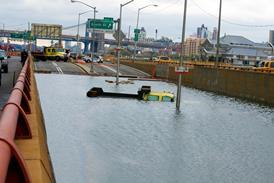Seemingly, the full impact of retail crime in 2001 has remained relatively stable at an estimated £2.4 billion (the corresponding figure for 2000 being £2.5 billion). Containing the figure at this level must be seen as a huge achievement for the industry, particularly when taking into account the substantial growth in sales value (annual retail turnover has increased by 9% over the past 12 months). In reality, the cost equates to £100 per household, or 1% of total UK retail turnover.
As a proportion of turnover, the BRC's figures for 2001 suggest that retail crime has fallen from 1.75% when the survey first began to the current level of 1%. A tremendous success story for the industry, then.
That said, this achievement has only really been possible because of the substantial investments that pro-active retailers have made in security provisions. CCTV and alarm systems come at a price. £2.7 billion over the past five years alone, if truth be told.
Retail Crime Reduction Partnerships
Losses have been stabilised in monetary terms – and reduced as a proportion of turnover – mainly because the retail community has taken the lead and worked in total partnership with other agencies. Over the past five years, for example, a highly successful network of Retail Crime Reduction Partnerships has been established in no less than 250 towns and cities right across the UK, including Swindon, Hexham and Brighton.
These partnerships bring together the BRC and individual retailers with the local police, town and shopping centre (security) managers, local authorities and regional Governments to determine and then develop effective crime prevention strategies.
Speaking at the official launch of the BRC's 9th annual survey, director general Bill Moyes said: "We know that young men are the most common retail criminals, and that their motivation is overwhelmingly to support a drug habit. A hard drugs habit will cost someone around £15,000 to fund every year. In reality, goods to the value of several times that amount will have to be stolen and sold on for the drug user to satisfy their craving."
In truth, deterrence is a far more effective approach to the problem than detention will ever be. As we've seen, retailers are playing their part, spending vast amounts of generated income on security while backing the aforementioned Retail Crime Reduction Partnerships. Partnerships that are all about identifying known criminals, sharing intelligence on them and, hopefully, catching them before further crimes are perpetrated.
The BRC is also playing the fullest possible role here. The organisation is working hard on a bespoke programme that will eventually see the Partnerships gain access to the latest crime fighting and management technology. This includes the ongoing development of a National Retail Crime Database covering the criminals, their associates, vehicles and other salient information.
However, in spite of all these sterling efforts the problem of retail crime cannot be said to be under control. Although the cost of customer theft is estimated to have fallen by £70 million to £830 million in 2001, the number of known incidents increased to just over 2,500 per 100 retail outlets (from 2,256 in 2000, a disturbing increase of 15%).
Crime reduction is one of this Government’s key deliverables. New Labour has emphasised that crime reduction is everyone’s responsibility. The retail sector fully accepts that premise, but it doesn’t mean the Government has no part to play in that
Bill Moyes, director general, BRC
The value of staff theft has increased from £590 million to £640 million, retail robberies are on the rise (from three per 100 outlets in 2000 to six) and we've again seen a disturbing increase in in-store violence against staff.
"This is a terribly worrying trend," added Bill Moyes. "It's also ample demonstration of the need to manage crime and criminals much more pro-actively, but in truth the retail industry can only do so much."
Government must play its part
In the eyes of Bill Moyes and Mike Schuck – the BRC's assistant director of retail crime – it's high time the Government afforded the issue of retail crime a much higher priority.
In truth, retail crime should be a key performance indicator for the 43 police forces throughout England and Wales. It isn't. At present, the police are often reluctant to respond to calls from retailers when members of staff have managed to apprehend villains. Through no fault of their own, the police are increasingly being forced to respond to those issues against which their performance is measured by Westminster.
Although the individual sums of money involved in many retail crimes are not huge, it's essential that the police back retailers in their efforts to combat shop theft and violence, and are actually seen to do so by the public at large. Retail crime merits that degree of priority.
The 2001 survey results
While offences of 'theft from a shop' recorded by the Home Office rose to 293,000 in 2000/2001, attitudes to retail crime displayed by the courts and the Crown Prosecution Service do not – in many cases, at least – appear to mirror the serious nature of retail crime. This can be seen in the numbers of detained offenders passed to the police, a figure which has declined from 63% in 2000 to 55% in 2001.
As we've seen, the cost of theft by customers to the retail trade in 2001 was £830 million, while the average number of known incidents rose by 15%. As ever, department stores suffered the most, each outlet surveyed experiencing an average of nearly 50 incidents. Meantime, the average value of goods stolen rose from £74 in 2000 to £111, with all sectors experiencing an increase in the average value of goods stolen.
The BRC survey goes on to state that: "Several retailers have reported reductions in the number of suspects passed to the police. This primarily reflects the fact that, in many instances, the process by which store security officers hand over suspects to the police service is seen to be too onerous and bureaucratic – particularly in the majority of cases where the CPS does not take action against the offender(s)." A parlous state of affairs that demands immediate rectification.
According to the BRC survey, known staff theft decreased slightly to 7.6% per 1,000 members of staff (the corresponding figure in 2000 being 8.1%).
Most important of all is the need for Government to support the retail industry in developing a truly effective national crime prevention network. The productivity of Retail Crime Reduction Partnerships has been well documented, but they have to operate o
Mike Schuck, Assistant Director(Retail crime), BRC
Burglary, arson and terrorism
Good news on the burglary front, it would seem. Scaling up the survey results to calculate a cost for retail as a whole shows that burglary stock losses and repairs cost an estimated £21 million in the latest survey period, down by some £9 million on 2000. Burglaries – and attempted burglaries – have shown a small decline in incidents since 2000, with 24 successful or attempted burglaries per 100 outlets in 2001.
Worryingly, cases of criminal damage to stores have increased. In some cases, retailers have told the BRC that criminal damage has risen as a result of some shop thieves damaging the goods they are trying to steal rather than be caught for shop theft. The sector most at risk here seems to be the department store, with 83 cases reported per 100 outlets.
Incidents of arson have remained relatively steady, with 2.8 cases per 100 outlets. That said, the average cost per incident has increased significantly, from £3,967 in 2000 to £15,052. Mixed retailers saw the biggest average cost per incident (at almost £95,000).
At the survey launch, the BRC's Mike Schuck highlighted the increasing importance of terrorism. "Acts of retail terrorism are very much on the rise," said Schuck, with some concern. "There was a total of 576 reported incidents of terrorism in 2001, ten of them actual and 566 being hoaxes. This equates to four cases per 100 outlets, an increase of 33% on the previous year." Yet another area of grave concern for the retail security professional.
Robbery and violence against staff
Retail robberies increased to six per 100 outlets in 2001, doubling-up on the previous year. The average loss per incident of robbery was £1,003, a significant decrease on the 2000 result of £2,929. As Mike Schuck rightly stated, however, it is not so easy to measure the human and social costs to the victims of such acts. "In the past 12 months two retailers have died during the course of attempted robberies on their stores," he said. "When offenders are caught, the judiciary must begin to send out a message that this is not a low risk crime."
Sadly, the BRC has had to report another increase in violent incidents against shop staff, with seven reported cases per 1000 members of staff in 2001 (up from four in 2000). This amounted to 52 cases of violence per 100 outlets in 2001, compared with 29 in the previous year. It's worth bearing in mind that this is a faster growth rate than that for retail crime in general, and must remain a major concern for the police and the Government.
Fraud on the increase
The BRC's '9th Retail Crime Survey 2001' reports that fraud of all types has increased by over 50% on 2000 levels, with cheque and payment card fraud accounting for nearly three quarters of all retail fraud losses. By far the largest increase is in the area of 'card not present' fraud (eg mail, telephone, Internet and interactive television). This has increased eightfold to no less than £15 million.
To counteract this particular type of fraud, the banking industry has recently devised and launched a new system whereby the consumer is required to give their home address when making a purchase by one of the aforementioned mediums. This is checked against the records held by the bank.
Cheque card fraud losses are, according to the BRC, higher per £million of total retail turnover (£97) than payment card losses (£74), although their rate of increase on last year is lower at £23 (+37%). The BRC has established a Working Group to examine ways of reducing retailers' fraud losses on cheques.
Town centre partnerships: retail crime fighting in action

Now, the situation is very different. 250 schemes have been set-up in places as diverse as Coventry, Manchester, Shrewsbury and Leicester – the core strategy of most including exclusion notices, CCTV, radio links and information sharing between the police and shopping centre managers. One scheme – designated the ‘Dover Partnership Against Crime’ – has been particularly effective. The port town of Dover has a population of 35,000, with 16 million people passing through its dual cruise terminals each year. “The initial core strategy for us to reduce crime,” stated PC Woodland, “involved installing CCTV, a Shop Watch radio link, town centre constables and a police photo sharing scheme.” An exclusion order scheme was then slapped on suspected or known criminals as the DPAC really took off. “Everyone came on board,” said PC Woodland, “from the retailers, Connex and the P&O Stena Line managers through to the Port of Dover Police.” As a result, there are now 50% less retail losses than in nearby Folkestone and, in 2001-2002, crime has been reduced by 22%. An excellent achievement.
Source
SMT
Postscript
Copies of the BRC's '9th Retail Crime Survey: 2001' (ISBN 0-11-702557-7) are priced at £100 (£90 to BRC members), and are available from The Stationery Office, PO Box 29, Norwich NR3 1GN. Alternatively, telephone 0870 600 5522 or e-mail: book.orders@tso.co.uk
SMT readers can also order online at: www.tso.co.uk/bookshop





















No comments yet